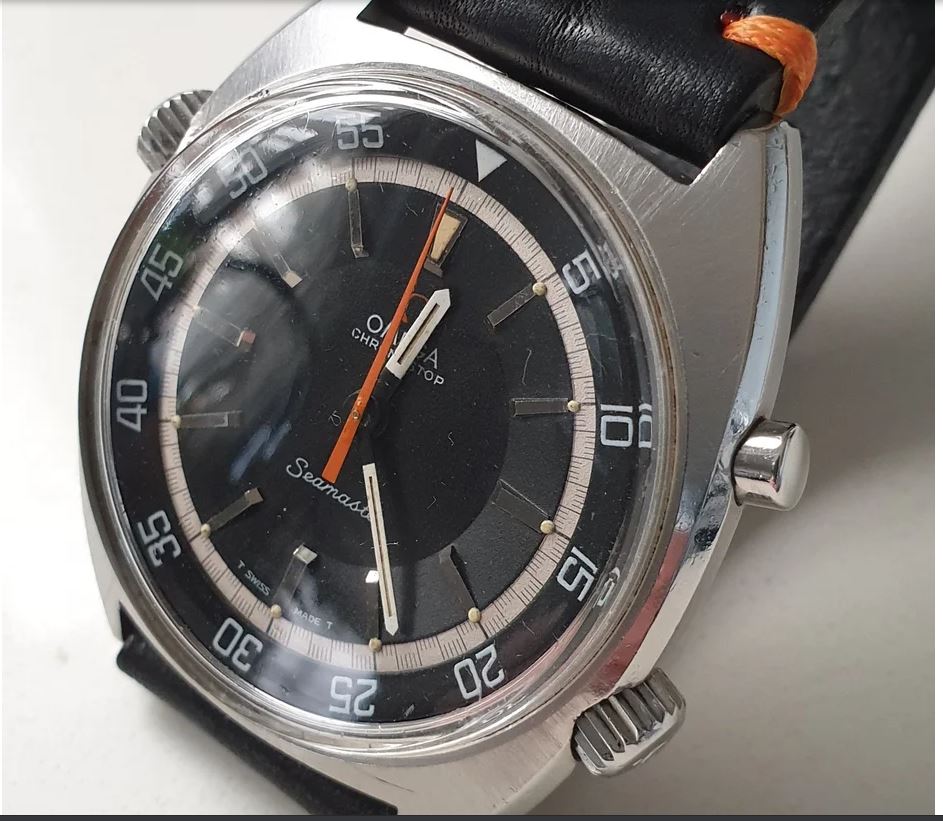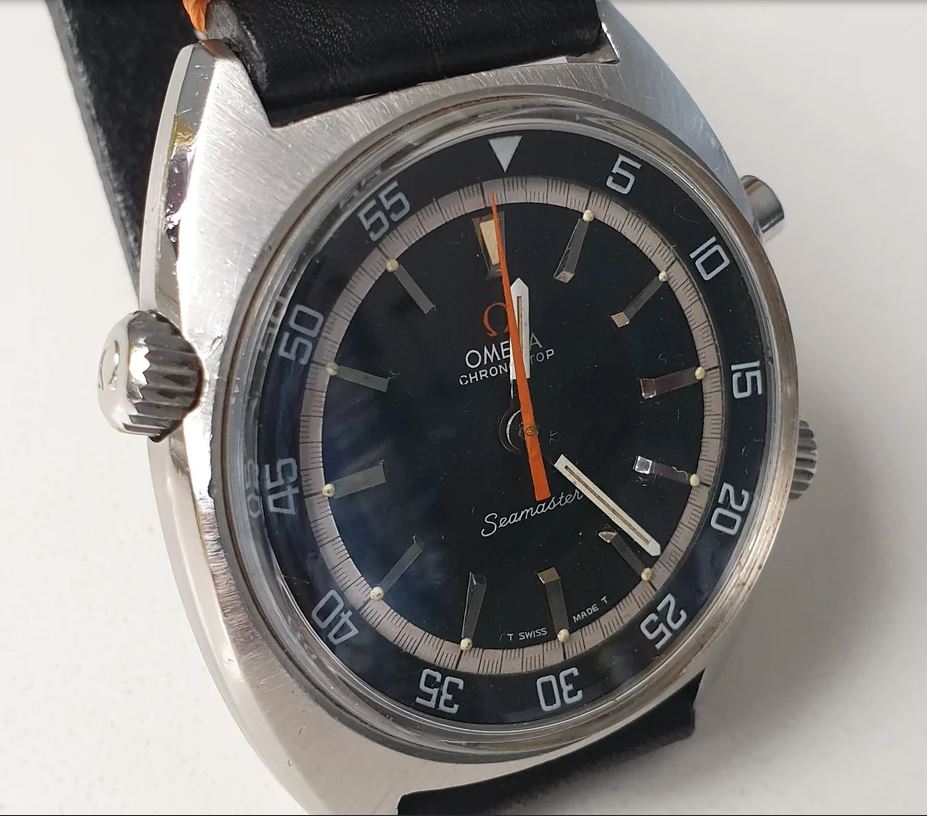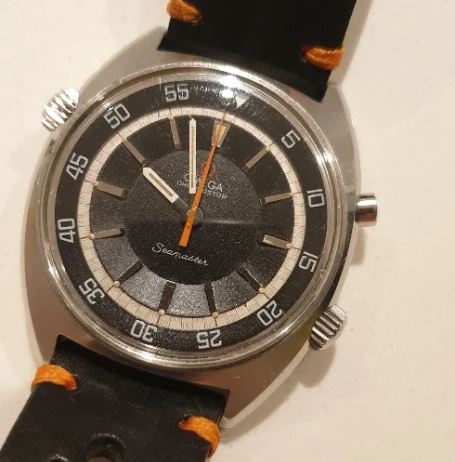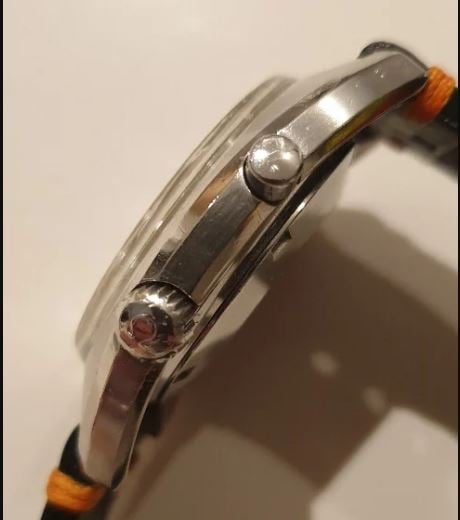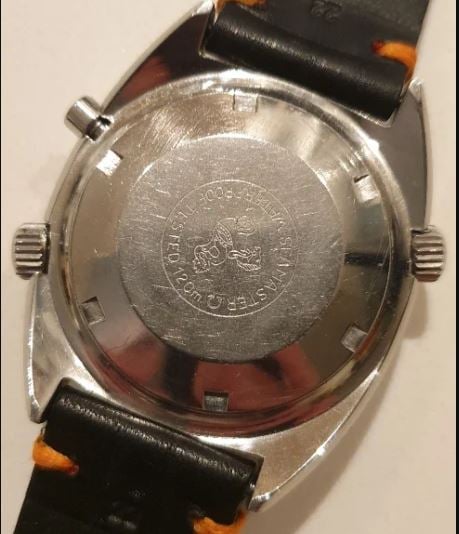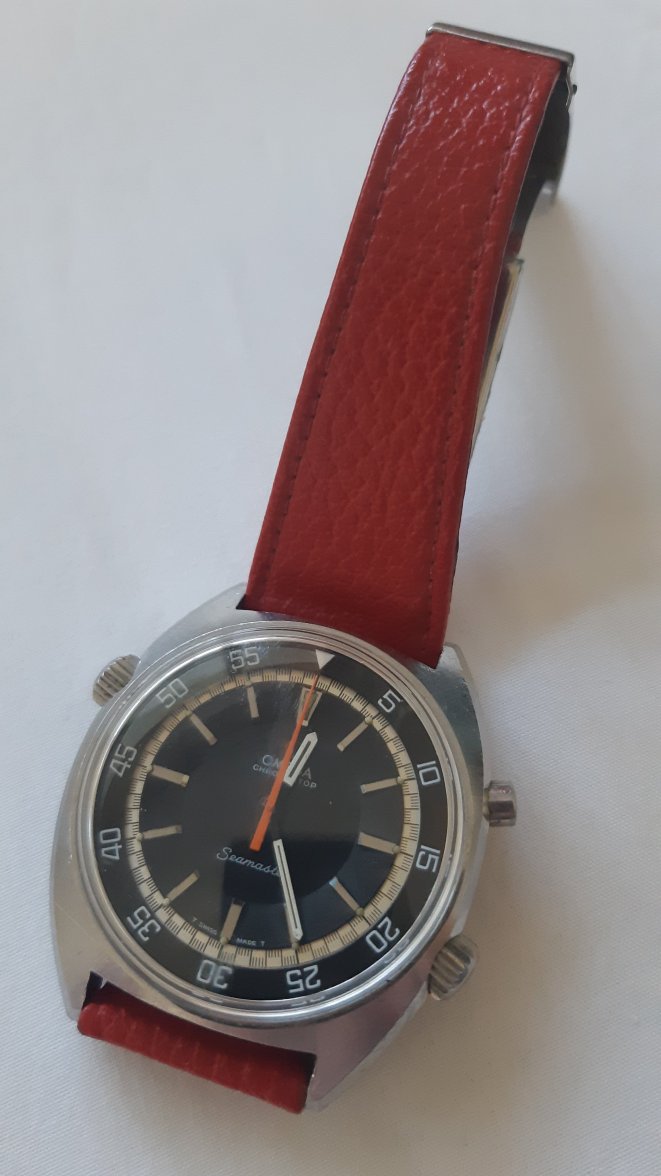Omega Seamaster Chronostop 145.008 - What's your opinion?
lillatroll
·Well it looks ok from the photos provided but they do give too much away as they are not very sharp. The case looks a little worn but not in bad condition. There are no movement shots. Any information about the movement? I've seen dealers asking around 1800usd and more for these, which is, to be honest, a little rich. I would say between 1200 and 1500 depending on condition. They are not an uncommon watch, nor extremely sort after, so be patient and find the best example you can.
Here is mine on an original NOS strap. It actually came on an original blue strap but that was quite worn. I got lucky and found this one. It's a nice daily wearer.
Here is mine on an original NOS strap. It actually came on an original blue strap but that was quite worn. I got lucky and found this one. It's a nice daily wearer.
Mr.Bliss
·Nope' no research, wouldn't know where to begin. Just sold a watch and had some money to spend.
Found this on Watchuseek and thought it looked interesting.
By the way does anyone know if its okay to post a "looking to purchase" thread as i dont have sufficient privilege yet.
Found this on Watchuseek and thought it looked interesting.
By the way does anyone know if its okay to post a "looking to purchase" thread as i dont have sufficient privilege yet.
Mr.Bliss
·Well it looks ok from the photos provided but they do give too much away as they are not very sharp. The case looks a little worn but not in bad condition. There are no movement shots. Any information about the movement? I've seen dealers asking around 1800usd and more for these, which is, to be honest, a little rich. I would say between 1200 and 1500 depending on condition. They are not an uncommon watch, nor extremely sort after, so be patient and find the best example you can.
Here is mine on an original NOS strap. It actually came on an original blue strap but that was quite worn. I got lucky and found this one. It's a nice daily wearer.
Very nice- What would you suggest looking out for? something you is extremely sort after.
Davidt
·The best way to start is by searching for other examples and sales threads of the same watch and start to compare details.
I can't offer much help on these other than to say the cases are often overpolished. Your example doesn't looks terrible but has certainly had the edges softened.
I can't offer much help on these other than to say the cases are often overpolished. Your example doesn't looks terrible but has certainly had the edges softened.
Mr.Bliss
·The best way to start is by searching for other examples and sales threads of the same watch and start to compare details.
I can't offer much help on these other than to say the cases are often overpolished. Your example doesn't looks terrible but has certainly had the edges softened.
Do you know if its okay to post a "looking to purchase" thread as i dont have sufficient privilege yet.
Davidt
·That's just a wtb ad which I believe you need 200 posts for.
Mr.Bliss
·The Chronostop is on OHPF, no great loss i guess. I guess i'll keep on searching.
lillatroll
·Nope' no research, wouldn't know where to begin. Just sold a watch and had some money to spend.
Found this on Watchuseek and thought it looked interesting.
By the way does anyone know if its okay to post a "looking to purchase" thread as i dont have sufficient privilege yet.
There is nothing stopping you PM ing members from the for sale section but the privilege rule is there for a reason. This is a community of collector and the buying and selling sections are for members who are actively part of the community. There are plenty of members here who I feel are trustworthy and plenty who I would not buy from if they were the last person on earth due to how I perceive them through their posts. It will pay off in the long run to be a bit patient.
Mr.Bliss
·It's easy to get carried away in the beginning. Spend some time getting to know what type of watch you want. There is nothing more deflating than getting a watch you think looks good in pictures and finding out in real time that it doesn't work for you. Think about when you would likely use it. Will it be a daily wearer or just for weddings etc. Scroll through the WRUW today thread, thousands of watches to look at to give you an idea of what you might like.
There is nothing stopping you PM ing members from the for sale section but the privilege rule is there for a reason. This is a community of collector and the buying and selling sections are for members who are actively part of the community. There are plenty of members here who I feel are trustworthy and plenty who I would not buy from if they were the last person on earth due to how I perceive them through their posts. It will pay off in the long run to be a bit patient.
Thank you very much.
wilderbeast
·It's easy to get carried away in the beginning. Spend some time getting to know what type of watch you want. There is nothing more deflating than getting a watch you think looks good in pictures and finding out in real time that it doesn't work for you. Think about when you would likely use it. Will it be a daily wearer or just for weddings etc. Scroll through the WRUW today thread, thousands of watches to look at to give you an idea of what you might like.
There is nothing stopping you PM ing members from the for sale section but the privilege rule is there for a reason. This is a community of collector and the buying and selling sections are for members who are actively part of the community. There are plenty of members here who I feel are trustworthy and plenty who I would not buy from if they were the last person on earth due to how I perceive them through their posts. It will pay off in the long run to be a bit patient.
Good luck in your hunt!
Mr.Bliss
·@lillatroll is spot on. If I’ve noticed anything about your posts so far, @Mr.Bliss, it’s that you have put up a lot of watches for comment and they’ve all been very different. The advice to take your time and refine what you really want will save you from regrets (and potentially losing money) further down the line.
Good luck in your hunt!
You are 100% correct - Seen a lot, purchased a few and learned a bit. All in all the only watch i have that i really like is this Zodiac.
Mr.Bliss
·Marsimaxam
·Call me a newbie, but I’m not familiar with this particular model... it’s a cool looking watch. I did a little research and came up with this article from the springbar... interesting read
Source: https://thespringbar.com/blogs/guides/omega-chronostop-145-008-collectors-guide/
In the case of premium luxury brands, there will always be an entry-level, a sense of belonging but not quite being there. It’s what the Boxster is to a Porsche’s 911, the Ghost to a Rolls’ Royce Phantom, the E-class to a Mercedes S-class. You’re given a gold membership invitation for an exclusive club when there are platinum and diamond doors just within arm’s reach. You are a karate student with a brown belt, inches but a world away to a seasoned master’s black. Close but not close enough. In the world of luxury watches, this makes all the difference. Unfairly, yet accurately, this characterizes the Omega Chronostop Reference 145.008. Released in 1966 as a third-fiddle to the technically superior- and significantly more expensive- Speedmaster and Seamaster chronograph models, it was designed for the young and up-and-coming; a whiff that there’s more to come.

Table of Contents
THE OMEGA CHRONOSTOP’S HISTORY
THE OMEGA CHRONOSTOP’S HISTORY
Upon its release in 1966, the Chronostop was equipped with all the bells and whistles afforded to a top-of-the-line sports watch of that era. With an extremely accurate 21,600 half beats per hour running speed, shock resistance and internal anti magnetic protection, it immediately garnered the top prize in the prestigious Federation Horologer competition. More notably, the Chronostop came equipped essentially with the same manual wind, 17 jewels Omega caliber 865 movement, as the technically superior Speedmaster models. Though it was merely missing the additional 12 hour register and external anti-magnetic dust cover, possessed instead by the Speedmaster,it was valued only at about half the price. Though at the time of its release it was considered as an expensive luxury watch a, the Chronostop is now regarded as one of the best bargains among vintage watch collectors. A total of 124,000 units were produced, and yet, it has become increasingly difficult to lay hands on an original piece, with prices going up to $3,000 for a prime specimen.

Taken from the 1968 Omega Chronostop catalog featuring the three variations of the turning scale series
VARIATIONS OF THE OMEGA CHRONOSTOP
The original Chronostop Reference 145.00 came with a Tonneau-shaped case with black, tritium point, luminous hour and minute baton hands. Its chronograph function had a sixty second stopwatch with an orange-colored dial, operated by pushing a button located at the 2 o’clock position. Always upholding its reputation as a high performance watch, three additional variations were released for the Chronostop Reference 145.008 from 1966 to 1969. All variations had a 41-millimeter stainless steel, waterproof tested case (120m) that came with either a leather or steel strap. They also shared a similar rotating inner bezel controlled by the crown located at 10 o’clock. All the variations displayed times to 1/5 per second.
The first variation was the Omega Seamaster “Pilot” Chronostop, featuring a 24-hour bezel with a second time zone. Released in 1967, the second variation, the Omega Chronostop Regatta, added yacht timers, especially designed for yachting enthusiasts. The countdown Chronostop came with a blue and red rotating yacht bezel. Lastly, the Seamaster Chronostop Jumbo Diver, released in 1969, was used extensively by amateur divers for the ease with which they could check their diving times, courtesy of the 0 to 60 scale. This variation came housed in a rare oversized (pristine) case, with an 865 manual winding movement exclusive for this specific variation.

Omega Seamaster “Pilot” Chronostop; B. Omega Chronostop Regatta; C. Seamaster Chronostop Jumbo Diver
SPECIFICATIONS
The 1960s were a time in which Omega was regarded as one of the premier watchmakers in the world. The quality of the build and workmanship of its watches arguably remain unmatched to this very day. Upon its release, the Omega Chronostop was marketed as a Technical Watch, powered by the in-house Caliber 865, with raw ebauches provided by the legendary watch movement manufacturer Lemania.

The Lemania Caliber 865 movement
MOVEMENT
The manual wind caliber 865 movement was released in 1966, specifically targeting the younger, less affluent buyers. Its 17 jewels provided it with an extremely accurate 21,600 bpm. Some may criticize this watch for its limited “stop-second watch” function, which allowed to record times up to one minute only, with the wearer having to rotate the inner bezels as a marker for minutes, making the process of recording longer times quite cumbersome. Nonetheless, it is significant to note that the 865 movement was, for all intents and purposes, a simplified version of the Calibre 861 found in the much more expensive Speedmaster line.

Cal. 861 (left) Cal. 865 (right)
MANUFACTURER OMEGA
Movement 865
Picture
Production run Year 1966
Casing Diameter 41 mm
Maximum Height
No. of Functional Jewels 17 J
Vibrations per hour 21, 600 bph
Markings
Shock Resistant Yes
Automatic winding No
Instant setting for day & date No
Bilingual for day of week No
DIALS
The dials for the different variations came in monochromes of black. The Pilot Omega Chronostop had “black sunskin”, the Regatta’s dials came in “matte black”, while the Seamaster Chronostop jumbo diver’s dials were simply black. All variations shared luminous batons for the hour and minute dials. They also shared the trait of having orange colored chronograph hands ,and the “Stop-second”, displaying 1/5 second divisions, enclosed in a white ring. Arabic numerals were in all three variations.

A. Omega Seamaster “Pilot” Chronostop in black sunskin; B. Omega Chronostop Regatta in matte black; C. Seamaster Chronostop Jumbo Diver in black
CASE
The Caliber 865 reference 145.008 has a diameter of 41mm and a 5.70mm high mainspring. The case was created in stainless steel and was tested to be waterproof up to 120 meters. Imprinted on the screw-back was an Omega logo, as well as an image of a seahorse. An acrylic crystal movement was used. Designed for very rugged use, the Chronostop Reference 145.008, as previously stated, was produced as a variation of other Omega models, targeted for specific users.

Omega’s trademark seahorse image
RECOMMENDATIONS
The Chronostop is not as well regarded as more expensive Omega models from the 1960s, such as the Speedmaster Professional. Better known today as the “Moonwatch”, it is famous for being strapped to Neil Armstrong’s wrist during the Apollo 11 mission. Yet the Omega Chronostop Reference 145.008 is, in essence, a simplified version of this vintage classic.

Speedmaster Professional Cal. 861 Ref. 145.022
When searching for an Omega Chronostop Reference 145.008 to add to your collection, look for a particular specimen that is near, or in mint condition. As most models are worn for having been used in rugged and trying conditions, it is difficult to find one without visible signs of wear and tear. It is recommended to acquire a piece having the original dials, distinguishable by the “Omega Chronostop, Geneve” signature. The movement should also bear the words “Omega Swiss, 17 Jewels”, on its pink gold bridge, to indicate authenticity. At the back, there should be an imprint of the Seamaster with the Omega logo, an image of a seahorse, and the words “waterproof tested 120m”. The watch must have been serviced only by Omega authorized service centers. If possible, ask for papers indicating that this has been done.

Remember that the Omega Chronostop Reference 145.008 was released in three variants, with a specific use intended for each of the models. As discussed above, the watch came in the guise of a divers’ watch, a regatta timer, and a pilots’ watch.
The “Pilot” Chronostop was designed with a 1/12-13/24 scale and came equipped with a feature that allowed the time of two different time zones to be read simultaneously. The function is achieved with the use of the inner 24-hour bezel set to a second-time zone. It is also affectionately called the “Roulette” bezel, because of its striking resemblance to a roulette wheel. This model was intended for global travellers and commercial airline pilots. These are some of the most notable things to look for when purchasing said variants.

The Pilot Chronostop’s distinctive Roulette bezel
SOMETHING DIFFERENT
The Chronostop Regatta also called the “countdown”, is distinguishable by a blue and red rotating bezel. The variant is designed with a 15-minute regatta scale that is ideally set for regatta countdowns. This comes as a function tailored for such races, as sailboats are positioned at a starting buoy when the gun goes off, and cross the starting line 15 minutes later. It is distinguished by the name “Seamaster” written below the dials. Very few of these models were ever sold, making it a very rare variant for this watch.

Chronostop Regatta’s blue and red rotating bezel
THE GRAIL
One of the most unique versions of the Omega Chronostop Reference 145.008 is the Jumbo Chronostop model. It features a rare inner rotating 24-hour bezel, controlled by the crown at 10:00. The one-button chronograph has a 40mm signed stainless steel screw-back case and reverse pie-pan dials with raised silver markers. The original dials come in matte black, while the chronograph has white hands and red chronograph sweep seconds. The acrylic crystal and crowns located at 4:00 and 10:00 should also be signed.

The Jumbo Diver Chronostop’s inner rotating bezel controlled by the crown at 10:00
WHAT TO LOOK FOR AND WHAT TO AVOID
All inner bezels rotate with the crown at 10 o’clock, so watch out for aftermarket replacements. The Omega Chronostop Reference 145.008’s strap came in leather or steel, a collector’s item in their own rite. The demand for vintage Omega watches has driven the price up, thus unmodified samples have become difficult to come by. As a rule, Omega watch parts are ordered by caliber number and must be accompanied by corresponding warranty papers.
From The Spring Bar Store:
Source: https://thespringbar.com/blogs/guides/omega-chronostop-145-008-collectors-guide/
In the case of premium luxury brands, there will always be an entry-level, a sense of belonging but not quite being there. It’s what the Boxster is to a Porsche’s 911, the Ghost to a Rolls’ Royce Phantom, the E-class to a Mercedes S-class. You’re given a gold membership invitation for an exclusive club when there are platinum and diamond doors just within arm’s reach. You are a karate student with a brown belt, inches but a world away to a seasoned master’s black. Close but not close enough. In the world of luxury watches, this makes all the difference. Unfairly, yet accurately, this characterizes the Omega Chronostop Reference 145.008. Released in 1966 as a third-fiddle to the technically superior- and significantly more expensive- Speedmaster and Seamaster chronograph models, it was designed for the young and up-and-coming; a whiff that there’s more to come.

Table of Contents
THE OMEGA CHRONOSTOP’S HISTORY
THE OMEGA CHRONOSTOP’S HISTORY
Upon its release in 1966, the Chronostop was equipped with all the bells and whistles afforded to a top-of-the-line sports watch of that era. With an extremely accurate 21,600 half beats per hour running speed, shock resistance and internal anti magnetic protection, it immediately garnered the top prize in the prestigious Federation Horologer competition. More notably, the Chronostop came equipped essentially with the same manual wind, 17 jewels Omega caliber 865 movement, as the technically superior Speedmaster models. Though it was merely missing the additional 12 hour register and external anti-magnetic dust cover, possessed instead by the Speedmaster,it was valued only at about half the price. Though at the time of its release it was considered as an expensive luxury watch a, the Chronostop is now regarded as one of the best bargains among vintage watch collectors. A total of 124,000 units were produced, and yet, it has become increasingly difficult to lay hands on an original piece, with prices going up to $3,000 for a prime specimen.

Taken from the 1968 Omega Chronostop catalog featuring the three variations of the turning scale series
VARIATIONS OF THE OMEGA CHRONOSTOP
The original Chronostop Reference 145.00 came with a Tonneau-shaped case with black, tritium point, luminous hour and minute baton hands. Its chronograph function had a sixty second stopwatch with an orange-colored dial, operated by pushing a button located at the 2 o’clock position. Always upholding its reputation as a high performance watch, three additional variations were released for the Chronostop Reference 145.008 from 1966 to 1969. All variations had a 41-millimeter stainless steel, waterproof tested case (120m) that came with either a leather or steel strap. They also shared a similar rotating inner bezel controlled by the crown located at 10 o’clock. All the variations displayed times to 1/5 per second.
The first variation was the Omega Seamaster “Pilot” Chronostop, featuring a 24-hour bezel with a second time zone. Released in 1967, the second variation, the Omega Chronostop Regatta, added yacht timers, especially designed for yachting enthusiasts. The countdown Chronostop came with a blue and red rotating yacht bezel. Lastly, the Seamaster Chronostop Jumbo Diver, released in 1969, was used extensively by amateur divers for the ease with which they could check their diving times, courtesy of the 0 to 60 scale. This variation came housed in a rare oversized (pristine) case, with an 865 manual winding movement exclusive for this specific variation.

Omega Seamaster “Pilot” Chronostop; B. Omega Chronostop Regatta; C. Seamaster Chronostop Jumbo Diver
SPECIFICATIONS
The 1960s were a time in which Omega was regarded as one of the premier watchmakers in the world. The quality of the build and workmanship of its watches arguably remain unmatched to this very day. Upon its release, the Omega Chronostop was marketed as a Technical Watch, powered by the in-house Caliber 865, with raw ebauches provided by the legendary watch movement manufacturer Lemania.

The Lemania Caliber 865 movement
MOVEMENT
The manual wind caliber 865 movement was released in 1966, specifically targeting the younger, less affluent buyers. Its 17 jewels provided it with an extremely accurate 21,600 bpm. Some may criticize this watch for its limited “stop-second watch” function, which allowed to record times up to one minute only, with the wearer having to rotate the inner bezels as a marker for minutes, making the process of recording longer times quite cumbersome. Nonetheless, it is significant to note that the 865 movement was, for all intents and purposes, a simplified version of the Calibre 861 found in the much more expensive Speedmaster line.

Cal. 861 (left) Cal. 865 (right)
MANUFACTURER OMEGA
Movement 865
Picture

Production run Year 1966
Casing Diameter 41 mm
Maximum Height
No. of Functional Jewels 17 J
Vibrations per hour 21, 600 bph
Markings
Shock Resistant Yes
Automatic winding No
Instant setting for day & date No
Bilingual for day of week No
DIALS
The dials for the different variations came in monochromes of black. The Pilot Omega Chronostop had “black sunskin”, the Regatta’s dials came in “matte black”, while the Seamaster Chronostop jumbo diver’s dials were simply black. All variations shared luminous batons for the hour and minute dials. They also shared the trait of having orange colored chronograph hands ,and the “Stop-second”, displaying 1/5 second divisions, enclosed in a white ring. Arabic numerals were in all three variations.

A. Omega Seamaster “Pilot” Chronostop in black sunskin; B. Omega Chronostop Regatta in matte black; C. Seamaster Chronostop Jumbo Diver in black
CASE
The Caliber 865 reference 145.008 has a diameter of 41mm and a 5.70mm high mainspring. The case was created in stainless steel and was tested to be waterproof up to 120 meters. Imprinted on the screw-back was an Omega logo, as well as an image of a seahorse. An acrylic crystal movement was used. Designed for very rugged use, the Chronostop Reference 145.008, as previously stated, was produced as a variation of other Omega models, targeted for specific users.

Omega’s trademark seahorse image
RECOMMENDATIONS
The Chronostop is not as well regarded as more expensive Omega models from the 1960s, such as the Speedmaster Professional. Better known today as the “Moonwatch”, it is famous for being strapped to Neil Armstrong’s wrist during the Apollo 11 mission. Yet the Omega Chronostop Reference 145.008 is, in essence, a simplified version of this vintage classic.

Speedmaster Professional Cal. 861 Ref. 145.022
When searching for an Omega Chronostop Reference 145.008 to add to your collection, look for a particular specimen that is near, or in mint condition. As most models are worn for having been used in rugged and trying conditions, it is difficult to find one without visible signs of wear and tear. It is recommended to acquire a piece having the original dials, distinguishable by the “Omega Chronostop, Geneve” signature. The movement should also bear the words “Omega Swiss, 17 Jewels”, on its pink gold bridge, to indicate authenticity. At the back, there should be an imprint of the Seamaster with the Omega logo, an image of a seahorse, and the words “waterproof tested 120m”. The watch must have been serviced only by Omega authorized service centers. If possible, ask for papers indicating that this has been done.

Remember that the Omega Chronostop Reference 145.008 was released in three variants, with a specific use intended for each of the models. As discussed above, the watch came in the guise of a divers’ watch, a regatta timer, and a pilots’ watch.
The “Pilot” Chronostop was designed with a 1/12-13/24 scale and came equipped with a feature that allowed the time of two different time zones to be read simultaneously. The function is achieved with the use of the inner 24-hour bezel set to a second-time zone. It is also affectionately called the “Roulette” bezel, because of its striking resemblance to a roulette wheel. This model was intended for global travellers and commercial airline pilots. These are some of the most notable things to look for when purchasing said variants.

The Pilot Chronostop’s distinctive Roulette bezel
SOMETHING DIFFERENT
The Chronostop Regatta also called the “countdown”, is distinguishable by a blue and red rotating bezel. The variant is designed with a 15-minute regatta scale that is ideally set for regatta countdowns. This comes as a function tailored for such races, as sailboats are positioned at a starting buoy when the gun goes off, and cross the starting line 15 minutes later. It is distinguished by the name “Seamaster” written below the dials. Very few of these models were ever sold, making it a very rare variant for this watch.

Chronostop Regatta’s blue and red rotating bezel
THE GRAIL
One of the most unique versions of the Omega Chronostop Reference 145.008 is the Jumbo Chronostop model. It features a rare inner rotating 24-hour bezel, controlled by the crown at 10:00. The one-button chronograph has a 40mm signed stainless steel screw-back case and reverse pie-pan dials with raised silver markers. The original dials come in matte black, while the chronograph has white hands and red chronograph sweep seconds. The acrylic crystal and crowns located at 4:00 and 10:00 should also be signed.

The Jumbo Diver Chronostop’s inner rotating bezel controlled by the crown at 10:00
WHAT TO LOOK FOR AND WHAT TO AVOID
All inner bezels rotate with the crown at 10 o’clock, so watch out for aftermarket replacements. The Omega Chronostop Reference 145.008’s strap came in leather or steel, a collector’s item in their own rite. The demand for vintage Omega watches has driven the price up, thus unmodified samples have become difficult to come by. As a rule, Omega watch parts are ordered by caliber number and must be accompanied by corresponding warranty papers.
From The Spring Bar Store:
Edited:
Mr.Bliss
·Call me a newbie, but I’m not familiar with this particular model... it’s a cool looking watch. I did a little research and came up with this article from the springbar... interesting read
https://thespringbar.com/blogs/guides/omega-chronostop-145-008-collectors-guide/
Thank you very much
X350 XJR
··Vintage Omega AficionadoMr.Bliss
·Wow, very nice. Thanks for sharing.
Marsimaxam
·Well it looks ok from the photos provided but they do give too much away as they are not very sharp. The case looks a little worn but not in bad condition. There are no movement shots. Any information about the movement? I've seen dealers asking around 1800usd and more for these, which is, to be honest, a little rich. I would say between 1200 and 1500 depending on condition. They are not an uncommon watch, nor extremely sort after, so be patient and find the best example you can.
Here is mine on an original NOS strap. It actually came on an original blue strap but that was quite worn. I got lucky and found this one. It's a nice daily wearer.
Very nice watch, I'm sure it looks better on a red strap, and I like the patina. I was looking on eBay, just to get an idea of what these models sell for, and other then the fact that sellers are mislabeling the versions, i.e, Regatta version as Pilot and what not, prices for the better examples are asking over 4k... doesn't mean they will get it of course.
How much should a mint Regatta version be selling for in your opinion? Take a look...
https://www.ebay.com/itm/Omega-Seamaster-Pilot-Dial-JUMBO-Chronostop-145-008-Cal-865-Vintage-1970-Watch/274445792114?_trkparms=aid=111001&algo=REC.SEED&ao=1&asc=20160908105057&meid=58ed4302e1d04aae8a00f89d2fb81460&pid=100675&rk=4&rkt=15&mehot=none&sd=274410152340&itm=274445792114&pmt=0&noa=1&pg=2380057&brand=OMEGA&_trksid=p2380057.c100675.m4236&_trkparms=pageci:80cd69e8-e588-11ea-9e68-622c255b94b5|parentrq:1d3f02321740a4d626e7a8caffffcd4e|iid:1
This website may earn commission from Ebay sales.
